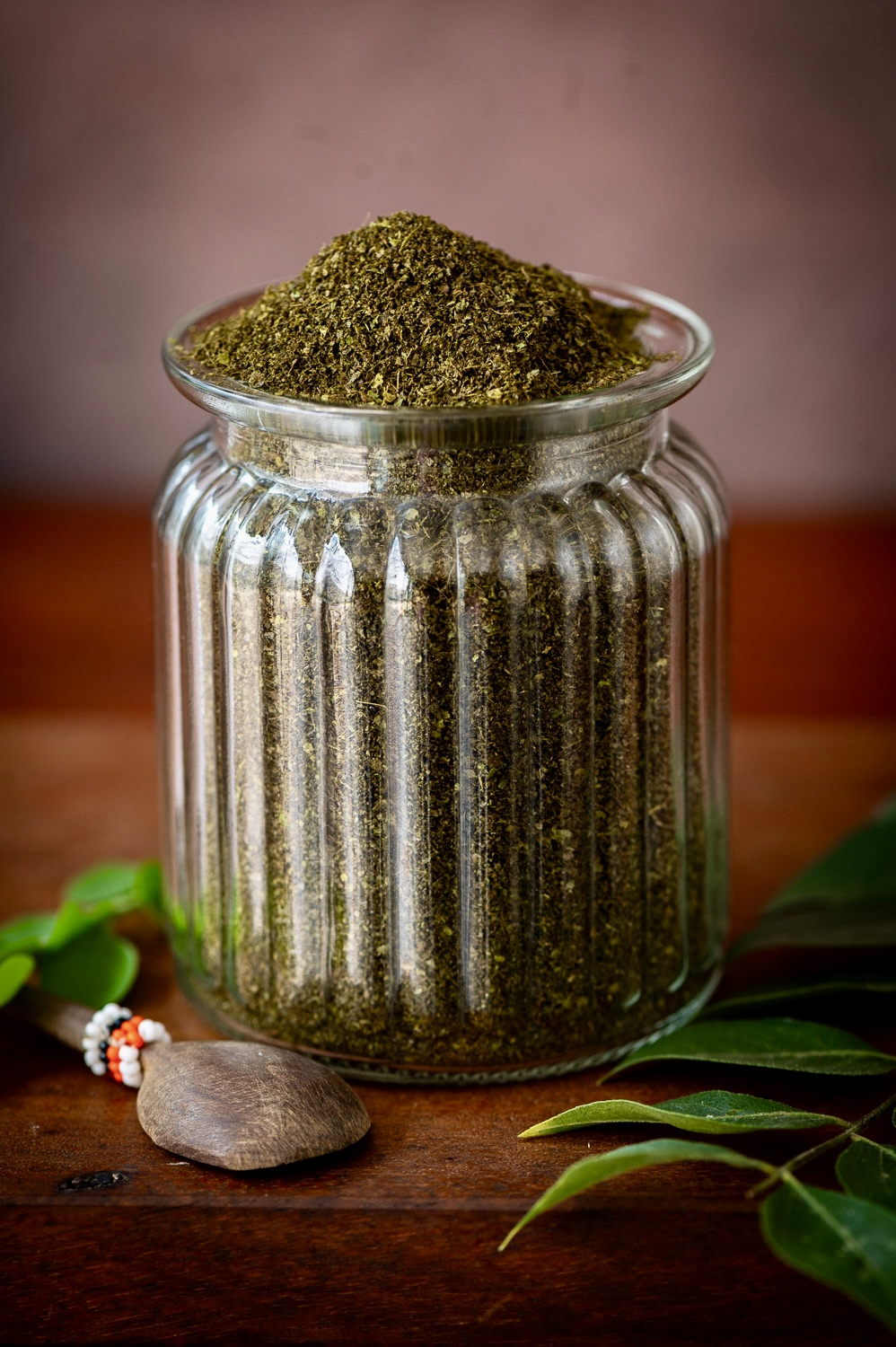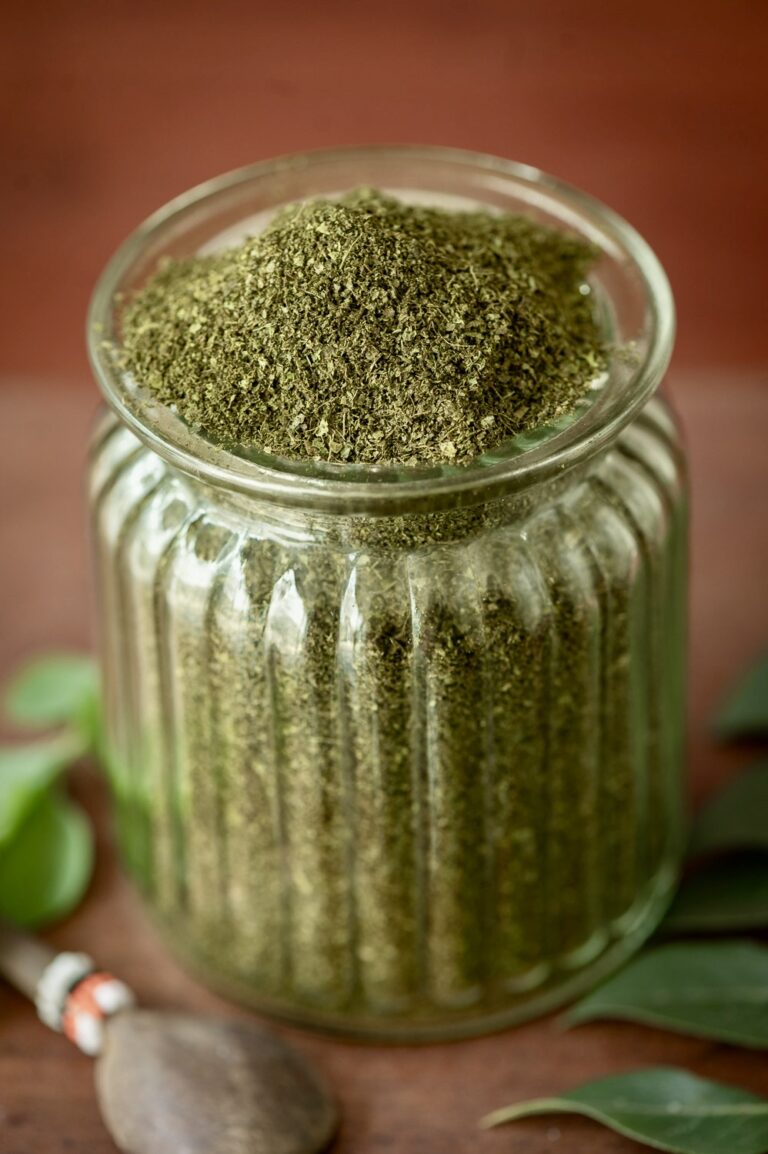Even though I grew up in Chennai and have enjoyed the regional cuisine throughout my life, when it comes to podis or condiment powders, I didn’t quite understand the nuances of the food type until I was older and began to really consider the technicalities of the art of cooking. I did not know, for instance, that idli podi is different from molagai podi (the recipe for which I shared with you recently), or that curry leaf podi is different from both of these. There are many other varieties too, of course, and each kind has particular uses.
As a child, at friends’ homes and at wedding celebrations, I would consume podis but didn’t really notice what kind was served. At most, I would wonder why a little spoonful of powder would be on one side of the banana leaf, and I would taste it but I would not necessarily think beyond that. By now of course, my awareness has deepened, and so has my expertise in preparation. I’m glad to share this curry leaf podi recipe with you, and I hope you’ll be able to discern its uniqueness too.
Curry leaf podi is usually enjoyed mixed into either gingelly oil or ghee and eaten as an accompaniment to hot rice, or else idly or dosa. It enhances the flavour of the main dish, and significantly cuts down on cooking time when one needs to eat in a hurry. It is the key to a very simple and fast meal that is still tasty. It also works beautifully when a meal contains a few more dishes, adding a touch of spice that elevates the plate (or the leaf) on the whole. Unlike pickles, which are very pungently flavoured, a podi is subtler while still packing a punch. The quantities consumed are more liberal as opposed to pickles, which is why blending into rice becomes possible. I also presume – or maybe I just imagine – that podis were traditionally used mostly in summertime when the curry leaf plant thrives and there is a dearth of vegetables, other than some water-based ones. Nature’s seasons and human resourcefulness both have deep impacts on how we eat, when we eat and how much we eat.
I have shared about the goodness of curry leaves before, along with some photos of the flowering shrub. You may have also noticed lush stems of it in many of my photographs across this blog. That is because whenever I want to incorporate a natural element into a frame, I often step into the garden and pluck some for my photoshoot. Here, we often take it for granted as it grows in many backyards. It is used across South Indian cuisines, and is truly one of the most delicious herbs in this part of the country. It imparts any dish it is used in with a distinct flavour. More often than not, most of us pick out the curry leaves and abandon them on the side of the plate, since the flavour has already been steeped into the dish, but this is a waste. The leaves have a nice taste themselves, and moreover are rich with antioxidants.
If you ever visit me at home, you may find me adding curry leaves to a Gujarati dal perhaps – but that is only because of my exposure, for it is hardly used in my ancestral cooking, if at all. It doesn’t grow there, but as I often say, I grew up right here – like this plant! Of course, my fusion experiments go beyond these two cultures, such as in the making of this curry leaf hummus. Here, however, I offer a condiment that is as authentic as possible.

Curry Leaf Podi
(Yield: Approximately 1½ cups)
1 tablespoon urad dal
1 tablespoon channa dal
1 teaspoon cumin seeds
1 teaspoon sesame seeds
1 cup fresh curry leaves
3-5 red dried red chilies
1 tablespoon desiccated coconut
½ teaspoon asafoetida
1 tablespoon oil
Salt to taste
Rinse and wash the curry leaves well. Then, pat them dry in a cloth. Lay them out in the sun to dry. In summer, they will dry up in a day. Alternatively, you could place them in the oven on a low temperature and allow them to dehydrate until they are crisp to the touch.
When ready to prepare the curry leaf podi, add the oil in a pan. Dry roast the urad dal, channa dal, sesame seeds, dried red chillies and cumin seeds until the ingredients are golden. Finally, add the desiccated coconut and asafoetida. Allow all these to roast all together for a short time.
In a blender jar, add all the roasted ingredients along with the dried curry leaves and salt. Blend until you get a coarse powder.
Store in an airtight jar. Serve with rice, idly and dosa, or experiment with using this condiment in your own versatile ways. I would eat it with rotis and theplas too, for instance. I have shared various other condiment recipes in the past – not just powders, but pickles and more too – and I hope you’ll explore my archives and find other interesting ways to liven up your enjoyment of a meal too.

